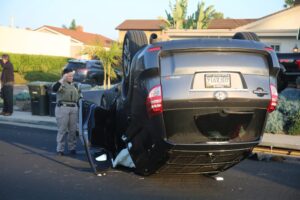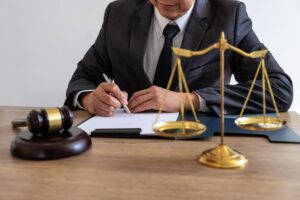When to Hire a Personal Injury Lawyer
When to Hire a Personal Injury Lawyer
If you sustained injuries in an accident resulting from another individual or entity’s negligence, you must immediately retain a knowledgeable personal injury lawyer. In almost all circumstances, accident victims must file a personal injury lawsuit within two years of their accident date. Otherwise, they waive their right to recover any monetary damages for their losses.
When you retain a personal injury attorney to represent you, they can begin advocating for your legal interests. An attorney can also file a timely claim or lawsuit in your case.
Your attorney will handle every step of the legal process for you and work to maximize your overall monetary award, helping you become whole again after your accident.
Schedule a Free Initial Consultation
Common Causes of Motor Vehicle and Pedestrian Accidents

Negligence from another driver can be critical in motor vehicle accidents and pedestrian mishaps. One primary cause is reckless driving, where a driver blatantly disregards traffic laws and safety. This may involve excessive speeding, weaving between lanes, or aggressive maneuvers that increase the risk of collisions with both other vehicles and pedestrians.
Distracted driving represents another dangerous form of negligence. With the ubiquity of smartphones, drivers frequently engage in activities such as texting, browsing, or talking on the phone while behind the wheel. This diverted attention compromises reaction times and awareness, making it more likely for the negligent driver to overlook pedestrians or fail to respond promptly to changing traffic conditions.
Failure to yield is another common manifestation of driver negligence that can result in accidents. Disregarding traffic signs or signals or neglecting to give the right-of-way to pedestrians at crosswalks can lead to collisions. This negligence may stem from impatience, inattentiveness, or a general lack of awareness of the surrounding environment.
Drunk or impaired driving is also a significant contributor to accidents caused by negligence. When a driver operates a vehicle while under the influence of alcohol or drugs, their coordination, judgment, and reaction times become severely compromised. This impairment endangers other motorists and poses a heightened risk to pedestrians crossing roads or navigating sidewalks.
Another factor linked to driver negligence is fatigue. Fatigued drivers, often grappling with drowsiness or even falling asleep at the wheel, exhibit impaired cognitive function and decreased alertness. Such drivers are more prone to making critical errors that can lead to accidents, endangering other drivers and pedestrians sharing the road.
Another driver’s negligence can instigate motor vehicle accidents or pedestrian mishaps through a wide range of hazardous behaviors. Addressing this issue necessitates a collective commitment to responsible driving and stringent enforcement of traffic laws to emphasize the importance of safe and attentive driving practices on local roads.
Complications that Arise from Injuries in Motor Vehicle and Pedestrian Accidents
Motor vehicle and pedestrian accidents can give rise to many complications, often extending beyond the immediate physical impact. One prevalent consequence is personal injury, varying in severity from minor cuts and bruises to more severe outcomes like fractures, concussions, or spinal injuries. These injuries may necessitate extensive medical intervention, leading to long-term physical rehabilitation and potential lifestyle adjustments for those affected.
Psychological trauma is another common complication arising from such accidents. Survivors may grapple with post-traumatic stress disorder (PTSD), anxiety, or depression due to the emotional toll of the incident. Witnessing or experiencing a traumatic event on the road can have enduring effects on mental well-being, affecting one’s ability to resume normal daily activities or drive without heightened anxiety.
Financial burdens often follow motor vehicle or pedestrian accidents. Medical expenses, vehicle repairs, and other out-of-pocket costs can accumulate swiftly, especially if the injuries are severe. Lost income due to time away from work during recovery further exacerbates the financial strain, creating economic challenges for those involved.
Permanent disability is a grave complication that may result from severe accidents. Life-altering injuries, such as loss of limb or paralysis, can significantly affect an individual’s independence, requiring extensive adjustments to living arrangements and lifestyle. These long-term consequences necessitate ongoing physical and emotional support for the affected individuals and their families.
Legal entanglements often ensue following accidents. Determining liability, insurance claims, and potential lawsuits can complicate a challenging situation. The legal aftermath may consume both time and energy, prolonging the resolution of issues stemming from the accident.
Effects on relationships are another nuanced complication. Accidents can strain family dynamics and friendships, especially if caregivers are needed or if the injured party requires significant support. Changes in roles and responsibilities can also create stress, and emotional strains may emerge as everyone involved grapples with the aftermath.
In summary, the complications arising from motor vehicle and pedestrian accidents are multifaceted, frequently encompassing physical, emotional, financial, legal, and interpersonal dimensions. Addressing these complexities necessitates a holistic approach, combining medical care, legal support, and emotional assistance to aid in the recovery and adjustment process for those involved.
Ways that a Personal Injury Lawyer Can Help
Engaging an experienced personal injury attorney can be instrumental in navigating the complexities that arise after a motor vehicle or pedestrian accident. One primary area where their experience proves invaluable is in assessing liability. A seasoned attorney can meticulously review the accident’s circumstances, scrutinizing evidence, witness statements, and relevant traffic laws to determine who is at fault. This is crucial for building a strong case and establishing the foundation for pursuing compensation.
Negotiating with insurance companies is another key role of a personal injury attorney. They have the knowledge and skills to effectively communicate with insurance adjusters, advocating for fair and just settlements for accident-victim clients. Insurance companies may try to minimize payouts, but an experienced attorney understands the intricacies of personal injury law and can ensure that victims receive the compensation they deserve, covering medical expenses, lost income, and other losses.
Legal procedures and paperwork can also be overwhelming for individuals without legal experience. A seasoned personal injury attorney can handle the intricate legal processes of motor vehicle or pedestrian accidents. From filing necessary documents to following deadlines and court procedures, their guidance ensures that the legal aspects of the case proceed smoothly, allowing the accident victim to focus on their recovery.
In cases where negotiations don’t lead to a satisfactory resolution, an experienced personal injury attorney will be prepared to escalate matters to litigation. They can represent their accident-victim clients in court, presenting a compelling case to seek compensation through a trial if necessary. This courtroom experience is particularly valuable in advocating for the accident victim’s rights and presenting a persuasive argument before a judge and jury.
Beyond the immediate legal aspects, personal injury attorneys often support accessing medical care. They can connect clients with reputable healthcare professionals and specialists, ensuring that injuries are thoroughly documented and treated. This proactive approach contributes to the accident victim’s well-being and strengthens the case by establishing a clear link between the accident and the resulting injuries.
Ultimately, the assistance of an experienced personal injury attorney is multifaceted. From investigating the accident and negotiating with insurers to managing legal procedures and advocating in court, their experience is pivotal in helping individuals navigate the aftermath of motor vehicle or pedestrian accidents, seeking justice and fair compensation for their physical, emotional, and financial challenges.
What Happens During Personal Injury Litigation and Trial?
Personal injury litigation and trials are intricate legal processes that unfold when a dispute arises from an individual sustaining injuries due to another party’s negligence. The journey through this legal landscape involves several key stages, each contributing to the pursuit of justice and compensation for the injured party.

The process often commences with filing a complaint in the court system. This document outlines the details of the incident, the injuries sustained, and the legal basis for holding the at-fault party (or defendant) responsible. Subsequently, the defendant responds with an answer, addressing the allegations and presenting their defense. This initial exchange sets the stage for the legal arguments unfolding during the litigation.
Discovery is a critical phase where both parties gather evidence to support their respective versions of the case. This process involves obtaining witness statements, depositing, and exchanging various documents. Depositions entail sworn, out-of-court testimonies that allow attorneys to assess witness credibility and gather additional information. Interrogatories, or written questions submitted to the opposing party, further contribute to discovering pertinent details.
If the case proceeds to trial, the courtroom becomes the arena for legal arguments, witness testimonies, and the presentation of evidence. Both sides engage in the examination and cross-examination of witnesses, seeking to persuade the judge or jury of the merits of their case. Opening and closing statements frame the narrative, while exhibits such as medical bills, medical records, photographs, and professional opinions provide tangible support for the arguments presented.
The judge oversees proceedings throughout the trial, ensuring adherence to legal standards and procedural rules. The jury, if applicable, plays a crucial role in evaluating the evidence and ultimately deciding the outcome. Once all parties have presented their case, the judge instructs the jury on the applicable law, and deliberations ensue.
The verdict, whether determined by a jury or judge, concludes the trial phase. If the injured party prevails, they may receive monetary damages to compensate for their medical expenses, lost income, pain, and suffering, among other applicable losses.
In essence, personal injury litigation and trials involve a meticulous progression from complaint to verdict, each stage designed to unearth the truth, establish liability, and determine the appropriate compensation for the injured party. An experienced personal injury lawyer can guide you through the litigation phase of your case and bring it to a successful resolution.
Recovering Financial Compensation in a Personal Injury Case

In a personal injury claim or litigation, an injured accident victim may seek various economic compensation to address the financial repercussions of their injuries. Designed to cover tangible losses and expenses directly incurred from the accident, these compensations aim to provide financial relief.
- Property Damage – In motor vehicle accident cases, compensation for property damage is a common economic recovery sought. This includes the repair or replacement costs for damaged vehicles and any other personal property affected in the accident.
- Medical Expenses – One of the primary economic compensations sought is reimbursement for medical expenses. This includes hospitalization, surgeries, rehabilitation, medication, and other related medical costs. The goal is to relieve the injured party from the financial strain of their healthcare needs.
- Rehabilitation and Therapy Costs – Beyond immediate medical expenses, compensation may be available for ongoing rehabilitation and therapy costs. This includes expenses related to physical therapy, occupational therapy, and any other rehabilitation necessary for the injured party to regain their range of motion and functionality.
- Lost Income– When injuries prevent an individual from working, they can seek compensation for lost income. This includes income lost during the recovery period and potential future earnings if the injuries lead to a diminished capacity to work or a permanent disability. Documentation such as pay stubs, tax records, and professional opinions may be necessary to substantiate these claims.
- Home Modifications – If the accident leads to injuries requiring modifications to the injured party’s home for accessibility, compensation may be available to cover these costs. This can include ramps, widened doorways, or other adjustments to accommodate the injured person’s needs.
- Transportation Costs – In situations where injuries impede the injured party’s ability to drive, compensation for transportation costs may be available. This can cover expenses related to public transportation, rideshare services, or modifications to a vehicle to accommodate the injured person’s mobility needs.
- Assistive Devices – In cases where injuries result in long-term or permanent disabilities, economic compensation may cover the costs of assistive devices, such as wheelchairs, prosthetics, or other adaptive equipment necessary for daily living.
These various types of economic compensation aim to address the tangible financial effects of injuries sustained in accidents. Seeking appropriate compensation during a personal injury claim or litigation ensures that the injured party can recover both physically and financially, allowing them to rebuild their life and move forward after the challenging experience of an accident.
Speak with a Personal Injury Lawyer Right Away

Greg Bentley, Personal Injury Lawyer
If you sustained injuries in an accident resulting from someone else’s negligence, you must immediately involve a skilled personal injury attorney. Your lawyer can promptly investigate your accident circumstances and gather the necessary documents to prove your personal injury lawsuit. Your lawyer can then negotiate with the insurance company on your behalf or pursue a favorable litigation result in the state court system.


